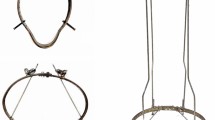Abstract
Study design
A retrospective, comparative study.
Objective
To compare the results, complications, and costs of preoperative halo-gravity traction in in- and outpatient settings.
Background data
Surgical management of severe spinal deformities remains complex and controversial. Preoperative halo-gravity traction results in a decreased need for aggressive surgical techniques, lower incidence of intraoperative neurologic complications, and improvement of nutritional parameters and preoperative cardiopulmonary function.
Methods
Twenty-nine patients younger than 18 years with kyphoscoliosis undergoing preoperative halo-gravity traction were divided into two groups: inpatients (n: 15) and outpatients (n: 14, home care or care at the Foundation). Traction time (weeks), traction weight (kg), radiographic curve correction, complications, and costs were compared. For statistical analysis, t test and odds ratio were calculated with a significance of p < 0.05.
Results
Mean traction time was 6 weeks for in- and 4 weeks for outpatients (p = 0.038). Initial traction weight was 6 kg in both groups, while final traction weight was 13 kg for in- and 15 kg for outpatients (p = 0.50). At the end of the traction period, coronal correction was 24° in in- and 28° in outpatients (p = 0.5), while sagittal correction was 27° and 29°, respectively (p = 0.80). Pin loosening was observed in 2 patients in each group, of whom 1 outpatient developed pin-site infection. In each group, one patient developed transient neurologic complications (odds ratio 1.091). Mean treatment cost per patient was 2.8-fold higher in inpatients.
Conclusions
Considering complications and costs, our results show that preoperative halo-gravity traction in an outpatient setting is an option to be taken into account.
Level of evidence
Grade III.
Similar content being viewed by others
References
Yang C, Wang H, Zheng Z et al (2017) Halo-gravity traction in the treatment of severe spinal deformity: a systematic review and meta-analysis. Eur Spine J 26:1810–1816
O’Donnell P, Anavian J, Switzer J et al (2009) The history of the halo skeletal fixator. Spine (Phila Pa 1976) 34(16):1736–1739
Rinella A, Lenke L, Whitaker C et al (2005) Perioperative halo-gravity traction in the treatment of severe scoliosis and kyphosis. Spine (Phila Pa 1976) 30(4):475–482
Nemani V, Kim H et al (2015) Preoperative halo-gravity traction for severe spinal deformities at an SRS-GOP site in West Africa. Protocols Complications and Results. Spine (Phila Pa 1976) 40(3):153–161
Koller H, Zenner J, Gajic V et al (2012) The impact of halo-gravity traction on curve rigidity and pulmonary function in the treatment of severe and rigid scoliosis and kyphoscoliosis: a clinical study and narrative review of the literature. Eur Spine J 21:514–529
Sink E, Karol L, Sanders J et al (2001) Efficacy of perioperative halo gravity traction in the treatment of severe scoliosis in children. J Pediatr Orthop 21(4):519–524
Park D, Braaksma B, Hammerberg K et al (2013) The efficacy of preoperative halo-gravity traction in pediatric spinal deformity. The effect of traction duration. J Spinal Disord Tech 26:146–154
Saeed M, Dacuycuy M, Kennedy DJ et al (2007) Halo pin insertion associated brain abscess. Spine (Phila Pa 1976) 32(8):271–274
Garfin S, Botte M, Nickel V et al (1987) Complications in the use of the halo fixation device. J Bone Joint Surg Am 69(6):954
Williams F, Nelms D, McGaharan K et al (1992) Brain abscess: a rare complication of halo usage. Arch Phys Med Rehabil 73(5):490–492
Tindall G, Flanagan J, Nashold B et al (1959) Brain abscess and osteomyelitis following skull traction. A report of three cases. Arch Surg 79:638–641
Garabekyan T, Hosseinzadeh P, Iwinski H et al (2014) The results of preoperative halo-gravity traction in children with severe spinal deformity. J Pediatr Orthop B 23(1):1–5
Teixeira da Silva L, de Barros A, de Azevedo G et al (2015) Management of severe and rigid idiopathic scoliosis. Eur J Orthop Surg Traumatol 25(suppl1):7–12
Li X, Zeng L et al (2017) Preoperative halo-gravity traction for severe thoracic kyphoscoliosis patients. Med Sci Monit 23:40214–44027
Funding
The authors declare that they have no competing interest. No conflict of interest or funding received during the conduct of this study. Funding: Not applicable.
Author information
Authors and Affiliations
Contributions
Design of study: NRD, VVR, CT, MN, EL, and SR; consulting references: NRD, MN, EB, EG, and RR; participation in draft manuscript: NRD, CT, and MN; revise manuscript: LP, IAFW, CT, RR, and MN; approved the final version of the paper: NRD, RR, CT, EB, IAFW, EG, and MN.
Corresponding author
Ethics declarations
IRB approval
The study was approved by the hospital Institutional Review Board (IRB) because the retrospective observational nature of the study IRB waived the informed consent.
Additional information
Publisher’s Note
Springer Nature remains neutral with regard to jurisdictional claims in published maps and institutional affiliations.
Rights and permissions
About this article
Cite this article
Davies, N.R., Vasquez Rodriguez, V., Remondino, R.G. et al. Inpatient versus outpatient halo-gravity traction in children with severe spinal deformity. Spine Deform 8, 711–715 (2020). https://doi.org/10.1007/s43390-020-00083-8
Received:
Accepted:
Published:
Issue Date:
DOI: https://doi.org/10.1007/s43390-020-00083-8




